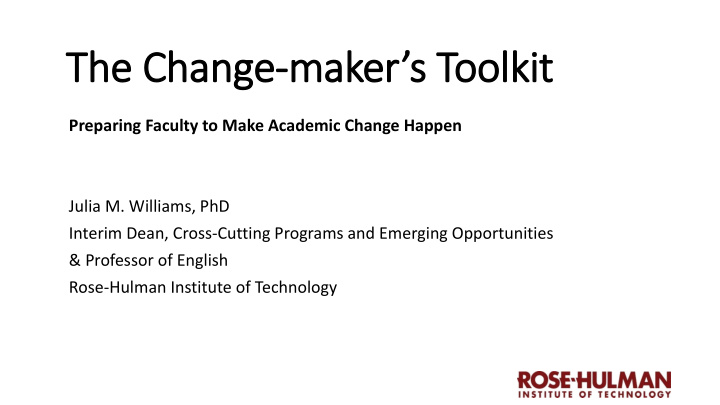



The Change- maker’s Toolkit Preparing Faculty to Make Academic Change Happen Julia M. Williams, PhD Interim Dean, Cross-Cutting Programs and Emerging Opportunities & Professor of English Rose-Hulman Institute of Technology
“How to start a movement”— Derek Sivers Video available at https://www.youtube.com/watch?v=V74AxCqOTvg&t=76s
Toolkits Suited to the Purpose
Time for some writing! Think for a minute about a recent change project that you have been engaged with… What particular skills, abilities, “tools,” were important to the success of the project? What “tools” might have helped you to accomplish your goals, if only you had them?
Four Categories of Change Strategies Focus on Changing Individuals DEVELOPING DISSEMINATING Reflective Teachers Curriculum & Pedagogy Emergent Final Condition Prescribed Final Condition Faculty Self-Development Development and Dissemination DEVELOPING DEVELOPING Policy Shared Vision Top Down Leadership Empowering Leadership Focus on Changing Environment/Structures *C. Henderson, A. Beach, and N. Finkelstein, “Facilitating change in undergraduate STEM instructional practices: An analyti c review of the literature. Journal of Research in Science Teaching , 48 (8), 952-984 (2011).
How they Work *C. Henderson, A. Beach, and N. Finkelstein, “Facilitating change in undergraduate STEM instructional practices: An analyti c review of the literature. Journal of Research in Science Teaching , 48 (8), 952-984 (2011).
Change tactics differ depending on the category. A. Promote project ideas/products to departmental and institutional leadership (e.g., adopt flipped classroom model) B. Provide opportunities within your institution for faculty to share good ideas and strategies related to the project goals (e.g., create a learning community) C. Empower a committee at your institution to make institutional change (e.g., revise reward structures) D. Create department, institutional, or community teams to create new projects through a collaborative process (e.g., constructing a shared vision, rather than seeking buy in, through strategic partnerships)
Assumption: People le and systems resis ist change Reality: Resistance is a symptom of 1. lack of alignment between strategies and tactic, 2. inappropriate change strategy, or 3. attempting to implement a change that is too distant from the status quo.
REvolutionzing engineering and computer science departments (RED) solicitation (2016) Departmental cultural barriers to change and to inclusion of students and faculty from different backgrounds must be identified and addressed . These and other threads aim to ensure that students develop deep knowledge in their discipline more effectively and meaningfully, while at the same time building their capacities for 21st century and “T - shaped” professional skills, including design, leadership, communication, understanding historical and contemporary social contexts, lifelong learning, professional ethical responsibility, creativity, entrepreneurship, and multidisciplinary teamwork. It is expected that, over time, the awardees of this program will create knowledge concerning sustainable change in engineering and computer science education that can be scaled and adopted nationally across a wide variety of academic institutions. The research on departmental change that results from these projects should inform change more broadly across the STEM disciplines.
Consortium (REDCON)
MACH Workshop 2018 May 30-June 1 academicchange.org
What is REDPAR? • Provide support for change competencies development among RED teams • Coordinate RED consortium activities (PI Kickoff Meeting, monthly calls, collaborative projects) • Examine the collective experiences of RED participants as a way to research change across institutions • Offer the opportunity for high-level comparison and analysis that would otherwise be lost.
REDPAR
The Change- Maker’s Toolkit l K Communication Cultural Context Risk Assessment Viewing Scale Shared Vision Partnerships Buy-In Influence
Change- maker’s Toolkit— Strategic Partnerships
Change- maker’s Toolkit— Communication More writing! Let’s work on creating the Change Lexicon for your project. Iowa State’s RED team brought their core image of the project on cross - functional teams — RIDE — to the RED PI meeting.
Change- maker’s Toolkit— Shared Vision Adrianna Kezar (2014) — the reason to empower stakeholders is not to eliminate resistance but to engage them in more than a nominal way. How Colleges Change: Understanding, leading, and enacting change. New York: Routledge.
REDPAR Research Questions Our research work poses fundamental questions: 1. How can academic departments successfully change? 2. What lessons can be extracted from their experience to increase the success of change at other institutions? 3. What features of the change experience are most notable?
The Change- Maker’s Toolkit l K Communication Cultural Context Risk Assessment Viewing Scale Shared Vision Partnerships Buy-In Influence This material is based upon work supported by the National Science Foundation under Grant No. #1540042. Any opinions, findings, and conclusions or recommendations expressed in this material are those of the authors and do not necessarily reflect the views of the National Science Foundation.
Recommend
More recommend